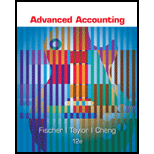
Concept Introduction:
Consolidation of Statements:
In today’s world of business acquisition of smaller companies is common and such acquisitions helps in the growth of the parent company. Once a company acquires another company the net assets of the other company is recorded in the books of the parent company. Consolidation of financial statements of both the parent company and subsidiary company is important for the stockholders of the parent company. A parent company may choose any of the two basic methods for consolidation and they are the equity method or cost method. The accounting methods used by a parent company for consolidation is purely based on their convenience.
To analyse: The components of non-controlling interest on consolidated
Want to see the full answer?
Check out a sample textbook solution
Chapter 3 Solutions
Advanced Accounting
- The goal of the consolidation process for A. The assets of the non-controlling interest to be predominantly displayed on the balance sheet. B. Asset acquisitions and 100% stock acquisition to result in the same balance sheet. C. Goodwill to appear on the balance sheet of the consolidated entity D. The investment in the subsidiary to be properly valued on the consolidated balance sheet.arrow_forwardHow is non-controlling interest in the subsidiary’s net assets presented in the consolidated statement of financial position? a. Within equity but separately from the equity of the owners of the parents. b. Within equity as part of retained earnings. c. Any of these as a matter of accounting policy choice. d. As a mezzanine item between liabilities and equity.arrow_forwardYou are required to prepare the consolidated statement of financial position as at 31 December x7. Assume: i. Non-controlling interest is measured based on the net assets of the investee on the acquisition date. il. Non-controlling interest is measured based on its fair value.arrow_forward
- Do you think the FASB made the correct decision in requiring consolidated financial statements to recognize all subsidiary's assets and liabilities at fair value regardless of the percentage ownership acquired by the parent?arrow_forwardWhat is the answer of following question? (a) Where the parent company does not hold 100 percent equity of the subsidiary company, what portion of theintra-group transactions between the parent entity and the subsidiary entity will need to be eliminated on consolidation? (b) What is a non-controlling interest, and how should it be disclosed? (c) How are non-controlling interests affected by intra-group transactions? (d) What are the three steps we use to calculate total non-controlling interest?arrow_forwardPlease concisely explain how the excess investment cost over book value is allocated. When is the intra-entity’s profits recognized on transfers between the investor and investee? What is the controlling interest percentage for a consolidated accounting financial statement?arrow_forward
- Ma3. Explain, with reasons, how the investments in a subsidiary and associate will be treated in the consolidated financial statements of a parent's group.arrow_forwardWhich of the following should appear in consolidated financial statements? a. All intercompany transactions properly recorded on each affiliate’s books. b. Transactions between the consolidated company and outside parties. c. Transactions not accounted for by the simple equity method. d. Lease transactions between a parent and subsidiary.arrow_forwardat acquisition date net assets of a subsidiary company are included in the consolidated financial statement at their acquisition date fair value.however most of the parents assests and liabilities are measured on historical cost.explainarrow_forward
- Provided are the consolidated trial balances of a parent and its less-than-wholly-owned subsidiary. Account Dr (Cr) Current assets Property, net Intangible assets, net Goodwill Liabilities Capital stock Retained earnings, beginning Accumulated other comprehensive income, beginning Noncontrolling interest Dividends Sales revenue Cost of sales and operating expenses Other comprehensive income Noncontrolling interest in net income Noncontrolling interest in other comprehensive income Total $5,000 105,000 10,000 80,000 (162,405) (10,000) (15,000) (200) (2,500) 1,000 (400,000) 390,000 (1,000) 100 5 $0arrow_forwardIn many cases, EPS is computed based on the parent’s portion of consolidated net income and parent company shares and convertibles. However, a different process must be used for some business combinations. When is this alternative approach required?arrow_forwardWhich consolidation method should be used in preparing consolidated financial statements in accordance with IFRS? A. Proportionate consolidation method.B. Either identifiable net assets or fair value enterprise method.C. New entity method.D. Parent company method.arrow_forward
